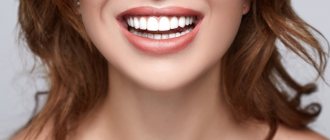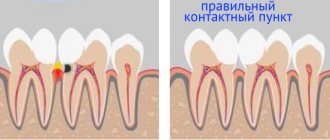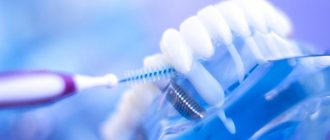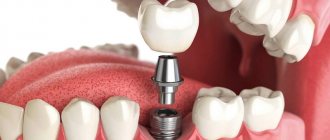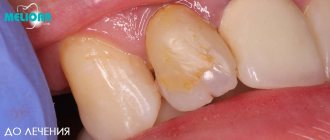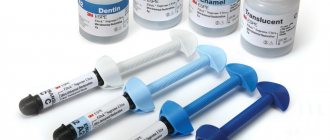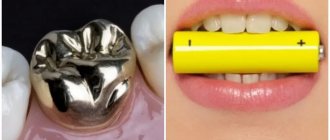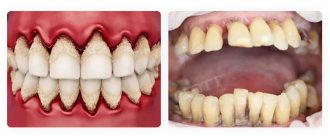Polyodontia is an anomaly in the development of the dental system, characterized by the appearance of many primary or permanent teeth. Supernumerary teeth often grow in the upper jaw. They can be small in size and cone-shaped. There are also additional teeth of drop-shaped, chisel-shaped forms.
Even one supernumerary tooth can cause a lot of inconvenience, and not only aesthetic ones: its appearance can lead to bite defects and significantly increases the likelihood of developing multiple caries due to crowding and hygiene problems.
The presence of several extra teeth aggravates the problem. This phenomenon leads to the inability to chew food normally. Incorrect distribution of the chewing load may cause insufficiently long service life of normal, complete teeth. In addition, due to a larger number of teeth, speech defects are often observed - it becomes simply impossible to pronounce some sounds. Therefore, it is important to consult a dentist with such a problem.
Causes of hyperdontia
Researchers have not figured out the exact reasons for the appearance of extra teeth. But there are several hypotheses that explain the pathology. Normally, the primary bite includes 20 teeth, and the permanent bite includes 28-32 teeth. The presence of one extra tooth may indicate a defect in a specific gene that has not yet been identified.
Anthropologists claim that our ancestors had more incisors on the upper and lower jaws. Supernumerary teeth can now act as a kind of atavism.
The influence of pathogenic factors during pregnancy can also cause an increase in the number of teeth in a set. The hereditary mutation is that more teeth are formed from the dental plate during embryonic development - it is split into a larger number of tooth germs.
It is important to know that there are many reasons for an increase in the number of teeth. This phenomenon is observed in some congenital syndromes:
- cleidocranial dysplasia;
- Rothmund-Thomson syndrome;
- adenomatous polyposis of the colon.
Therefore, sometimes such a symptom is a reason to contact not only a dentist, but also specialists of another profile, for example, a geneticist or gastroenterologist.
Ask a Question
When will the service be available?
Encouraged by the positive result, Tokyo scientists began further study of this area. Today, they are successfully working on the differentiation of the created rudiments, which would allow precise positioning of the alveolar ridge section with the crown number.
New Dentistry of the Future: Growing Teeth
The scale and pace of research allowed scientists to assume that by 2030, the method of growing human teeth will become widespread and will gradually replace prosthetics and implantation.
Symptoms of hyperdontia
Polyodontia usually manifests itself during one of the following age periods:
- Newborn. The pathology is detected during the first examination of the child; a neonatologist may detect an erupted tooth in the oral cavity or suspect an abnormal development of the jaw.
- From 4-7 months to three years, during the formation of the primary occlusion.
- From 5−7 to 18−25 years during the formation of permanent dentition.
The extra tooth is usually located in the midline of the face, between the central teeth. It is characterized by its small size, shortened root system and conical crown, tapering closer to the cutting edge. However, in some cases, the size and shape of the crown are completely normal.
The second most common option is an extra fourth molar. It may correspond to the normal size of a regular chewing tooth or be smaller.
An additional unit of dentition can erupt anywhere or remain in the thickness of the bone tissue in the form of a rudiment. Cysts often form in the area of such unerupted teeth. This process is not characterized by pronounced symptoms, so the pathology is discovered by chance, as part of a diagnosis carried out for another reason. The best way to make a diagnosis in this case is radiography.
A decrease in local protective forces can lead to exacerbation of periodontitis, swelling of the gums, redness of soft tissues, and the formation of fistulous tracts with the contents of the cyst being released. This is one of the common complications of unerupted supernumerary teeth.
There are other possible consequences of the anomaly:
- retention and dystopia - impossibility of eruption of a normal tooth, change in its normal position (eruption at an angle, rotation of the incisor along the axis, etc.);
- diastemas, trema: gaps between teeth, central incisors;
- anomalies in the position of the teeth, including their location in the palate, displacement towards the cheeks;
- discrepancy between the sizes of the dentition and jaw, which leads to crowding and bite defects.
Long-term consequences of this phenomenon include tooth decay due to caries or excess pressure due to lack of space in the jaw.
From the history
The first developments on this project began in England in 2002 . For their experiment, the team used crowns from six-month-old piglets and rats .
The research team was led by Pamela Yelick. Immature dental tissue cells removed from piglets placed in enzymes.
Innovations in dentistry
After their formation, the cells were transferred to a polymer plate, which gradually decomposed during cell development. Fully formed rudiments were implanted into rats .
Exactly 3 months later, the rats had new crowns with defective dentin, a complete absence of enamel and an unformed root.
Based on previous research, the experiment was continued by scientists from the Tokyo University of Sciences in 2007 . Takashi Tsuji and his colleagues were able to grow new teeth and successfully implant them in young mice .
The newly grown organs fully performed their functions. They had formed dental tissues and lacked the root part.
The best result was achieved by the same group, but already in 2009 . For their research, Tokyo scientists used a different technology than what was used previously. To form the germ, they took mouse cells responsible for the development and growth of teeth , and stimulated their growth in a collagen environment.
After that, were planted in place of the removed crowns. In their place normal teeth grew with a complete crown and root part. During growth, a neurovascular bundle was formed , which is responsible for further nutrition of the dental tissue.
What effect does black toothpaste from Thailand have and where to buy it.
Popular Parodontax toothpaste: here is the description, composition and reviews.
Follow the link https://zubovv.ru/krasota-i-uxod/zubnyie-pastyi/roks-otzyivyi-vidyi-preimushhestva.html reviews about Rox “Active Calcium” toothpaste.
Varieties of polyodontia
There are several forms of polyodontia in humans:
- Atypical. The extra units do not grow in the alveolar socket or even within the dentition. For example, a tooth germ can form in the body of the palatine bone.
- Typical. A supernumerary tooth grows within the dentition. This happens more often with small sizes of the dental unit, when there is enough space for it in the row.
- False. Delay in the rate of change in the primary occlusion. The rudiments of permanent teeth erupt when the milk teeth have not yet fallen out. They can erupt behind, in front and even outside the dentition.
- True. Formation of the rudiments of supernumerary teeth, in which the location of the tooth may not be limited to the dentition.
A separate category is genetic diseases, in which supernumerary teeth are often formed. These include cleidocranial dysplasia, when there are defects in the development of the skull bones, complete or partial absence of the clavicles. It provokes dental anomalies and adenomatous polyposis of the colon - the appearance of multiple polyps in the large intestine. Rothmund–Thomson syndrome is also characterized by multiple pathologies, including skin, nails and teeth.
Intercellular matrix
But the resource of stem cells for growing teeth is not even half the battle. For the development and formation of a complex structure of mature tissue, a support, a scaffold of intercellular matrix molecules is required: it is this that supports the attachment, migration and spatial organization of cells. The gaps and pores in it ensure the movement of cells, growth factors and metabolism. An artificial scaffold must be easy to use, biocompatible, degradable in the body and low immunogenicity, good mechanical properties, etc.
Among the synthetic materials for scaffold formation, it is worth mentioning “bioactive” glass, which can grow together with biological tissues, polylactic acid and composites based on metal, ceramics or polymers. All of them make it possible to produce scaffolds of the required shape, although their use remains very limited due to low biocompatibility and toxicity. In contrast, natural biomaterials for scaffolds—such as collagen, chitosan, or hyaluronic acid—are biocompatible and easily biodegradable. However, they are less durable and can cause rejection reactions.
In any case, the ideal scaffold material would be a structure derived directly from natural extracellular matrix polymers or from their synthetic analogues. Pulp and periodontal stem cells growing on such a scaffold, when treated with appropriate signal substances, successfully developed in the odontogenic direction - towards the formation of tooth tissue. However, we will return to this later, but for now we need a third type of ingredients.
Possible complications with polyodontia
The most common consequence of polyodontia is an unaesthetic smile, facial disproportions, as well as impaired diction, usually a lisp. In especially severe cases, extra teeth are noticeable even at rest, when the mouth is closed. Lips may protrude unnaturally or jaws may not close properly.
Additional teeth put pressure on the complete ones and take up space in the dentition. Teeth can shift, rotate along an axis, be located outside the row - on the palate, under the tongue, etc. Supernumerary units of the row cause crowding of the teeth. This complicates hygiene, provokes the accumulation of plaque, the formation of tartar, multiple caries and complications in the form of pulpitis and periodontitis.
When crowding occurs, the tissue around the teeth does not form correctly. In addition, the chewing load is distributed incorrectly. This can cause diseases of periodontal tissues - gingivitis, periodontitis, periodontal disease, in which deep periodontal pockets are formed, tooth mobility and further loss are observed. When overcrowding occurs, normal prosthetics are almost impossible without prior orthodontic treatment.
This disease leads to functional disorders, cosmetic defects, and therefore is one of the causes of self-doubt and interferes with normal communication and adaptation in society.
Price
According to scientists, this technique will have the same cost as standard prosthetics using implantation, since its cost is not so high.
But if we take into account market marketing, then even if widespread, for at least 10 years after its appearance in clinics, this service will be the most expensive of all dental work .
If you find an error, please select a piece of text and press Ctrl+Enter.
Tags growing teeth scientific developments future technologies
Did you like the article? stay tuned
Diagnosis and treatment
High-quality and timely diagnosis allows you to prevent possible complications and take timely measures to eliminate the problem. Most often, extra teeth are located in the anterior part of the upper jaw. The more accurately the position of the units is determined, the better the surgical treatment will be.
In children, removal of supernumerary teeth is carried out as carefully as possible to avoid damage to the growth zones of complete teeth and the formation of bone defects in the alveolar process. Therefore, radiography is performed - it allows you to determine the position of the teeth, features of the root system, and evaluate the relative position of units in the thickness of the jaw bone.
The following diagnostic methods are used:
- CT;
- Orthopantomography (OPG);
- targeted image - intraoral radiography (when assessing the condition of one or two teeth);
- MRI.
CT allows you to obtain a layer-by-layer image of bone structures in a matter of minutes. The method is relevant when it is necessary to obtain an image of a tooth in different planes. The radiation dose in this case will be safe, and the procedure is easily tolerated by most patients and does not require any preparation.
Orthopantomography (OPG) is a method that involves performing a panoramic image of the entire jaw, as well as adjacent tissues and structures of the facial skeleton. Can be performed on patients aged three years and older. This is a quick, simple and very informative method that helps to get a general idea of the condition of the dental system. If you suspect multiple supernumerary teeth, as well as when planning orthodontic treatment, it is especially relevant.
Intraoral radiography is the simplest and most popular diagnostic tool. The image can provide an image of 1-4 teeth, depending on their size, as well as the structures adjacent to them. When identifying many extra teeth, this method will be less effective, but can be used if it is impossible to use others.
It is also used as part of surgical treatment planning if supernumerary teeth are removed one at a time. An accurate determination of the relationship of the additional unit with the root systems and rudiments of normal teeth is carried out using intraoral radiographs before surgery and some time after it. Using this method, it is possible to determine the degree of changes in the position of the impacted tooth, the condition of the roots of complete teeth, the structure and condition of the bone in the area under study.
It is also used as part of surgical treatment planning if supernumerary teeth are removed one at a time. An accurate determination of the relationship of the additional unit with the root systems and rudiments of normal teeth is carried out using intraoral radiographs before surgery and some time after it. Using this method, it is possible to determine the degree of changes in the position of the impacted tooth, the condition of the roots of complete teeth, the structure and condition of the bone in the area under study.
Age is not a barrier
I am 65 years old. The doctor suggests installing implants. Is this harmful at my age?
Alexey Petrovich, Balashikha
– In the middle of the last century, when dental implantation was just becoming part of widespread dental practice, contraindications to the installation of implants were quite strict. They were not installed in elderly people, patients with diabetes mellitus, or autoimmune diseases. But with the current level of medical technology, implants can be recommended to almost all patients at any age. By the way, there are no restrictions on the number of implants installed at a time. The only danger associated with this procedure is the use of general anesthesia, which can pose health risks.
However, you need to understand that the lifespan of an implant depends on your oral hygiene. If it is insufficient, it can lead to gum disease and loss of the implant.
Treat without a drill. What procedures have dentists refused? More details
Treatment of polyodontia
If hypodontia - fewer teeth than normal - requires the restoration of missing units, then with supernumerary teeth the approach may be the opposite. There are standard protocols for providing care in each case. The only correct approach is complex treatment, and the tactics of surgical, orthopedic, and orthodontic treatment are determined individually. Not only the number and relative position of extra teeth are taken into account, but also the rate of jaw growth and development of the dental system.
Treatment is possible only with a collegial approach; it is carried out by a whole team: a dental surgeon, an orthodontist, an orthopedic dentist. For children, a pediatrician or neonatologist is involved in developing a treatment program. Sometimes the help of an oral and maxillofacial surgeon is required.
There are two main areas of treatment: surgical and orthodontic. Surgical intervention is indicated in all cases where an extra tooth affects the formation of the bite. Removal may be complicated by the fact that it does not erupt completely, is located close to the root systems of complete teeth or to the rudiments, the maxillary sinus of the upper jaw or the mandibular nerve of the lower jaw. Therefore, after removal in children, it is important to monitor the condition of the little patient for another year.
It is recommended to remove additional teeth from the age of 8, during the period of change of the frontal group of teeth. This will prevent dental deformation and malocclusion. Only if there is a high risk of damage to a normal tooth germ in close proximity, the doctor will recommend postponing the operation.
With false polyodontia, removal of baby teeth usually does not cause problems. The root systems of such teeth are already resorbed in most cases, and the risk of complications is extremely low.
The type of operation is determined by the location of the tooth, the degree of its adherence to the complete teeth, the depth of its location in the bone tissue, age characteristics and other factors.
Orthodontic treatment is also determined by the specific situation. It is usually used after the surgical stage, if the additional tooth has already had a certain effect on the bite. Functional devices can be chosen as a correction method: plates, aligners, and braces.
Signaling pathways
Stem cells are our main resource, the scaffold is the basis for its development, but their interaction must be orchestrated by signaling molecules, including growth factors and interfering RNA. Growth factors are peptide molecules that transmit signals to control cellular behavior through action on specific receptors on the surface of cells. They provide interconnection and interaction between cells, as well as between them and the extracellular matrix. So, if the carious cavity is close to the sensitive pulp or the patient experiences increased tooth wear, the corresponding growth factors trigger the formation of secondary and tertiary dentin. A number of growth factors have also been identified that act during tooth development, such as bone morphogenetic protein (BMP), platelet-derived growth factor (PDGF) and fibroblast growth factor (FGF). They are delivered to stem cells using nanoparticles or through the scaffold itself, filling it with the desired set of molecules.
Interfering RNA molecules are also used to control cell differentiation. They bind to messenger RNA and stop the synthesis of a particular protein. For targeted delivery, such RNA is converted into DNA and transferred into a cell in the form of a plasmid. Now we have everything we need to obtain a tooth: dental stem cells (assorted), scaffold (product identical to natural) and growth factors (to taste).
Prognosis and prevention
There is no specific prevention of hyperdontia, since the exact reasons for the appearance of additional units of the dentition are unknown. You can only prevent the consequences of false hyperdontia - it is important to monitor the rate of change in the primary occlusion and take action if the primary tooth does not fall out in due time.
Most often, the prognosis for treatment is favorable. Modern possibilities will allow you to restore the aesthetics of your smile and the function of your teeth. The main treatment tactic is the removal of excess row units and subsequent correction of the position of the remaining teeth. In childhood, it is usually possible to get by with removable orthodontic appliances. Adults are most often recommended to wear braces and the subsequent retention period (wearing retainers).
It is advisable to preserve supernumerary teeth only if they are capable of bearing the load during planned orthopedic and orthodontic treatment, can be a full-fledged unit of the dentition, and can replace complete teeth that cannot be restored due to their severe destruction by trauma or caries. The decision on the treatment method is made by a team of dentists from different fields.
You can get qualified help from dental surgeons, orthodontists and orthopedists for hyperdontia at the STOMA clinic. To schedule a consultation, call the number provided or fill out a special form on the website.
Animal experiments
Photo: growing a real living tooth
The stem cell complex was infused into mice. In order to be able to monitor the process in detail, green fluorescent protein, which is safe for the mice, was added to the cells.
This experiment ended with the appearance of a new tooth. The studies carried out showed the following:
- do not differ in shape from a real tooth;
- the anatomical structure included exactly the same elements : pulp, neurovascular bundle, dentin, enamel;
- dental tissues had high strength , allowing them to fully perform all functions;
- the size of the coronal part was slightly smaller than standard values.
This video talks about the methods by which scientists managed to achieve their first results:
Age-related changes in dental pulp
Regressive and age-related changes in the dental pulp also affect dental health. Over the years, the pulp decreases, and fibrous changes are often observed in its tissues. Mineral deposition negatively affects the condition of blood vessels and capillaries. Atherosclerosis of pulp vessels occurs in many people over 50 years of age. Because of this, tooth tissues no longer receive proper nutrition, which is why they become more fragile and vulnerable. Many people are interested in how to determine a person’s age by looking at their teeth. Only a medical examination can provide more or less accurate data. It is very difficult to determine a person’s age by looking at their teeth, since even relatively young people’s teeth can be in very poor condition, and vice versa.
Comments
Can you tell us in more detail about Norbekov’s technique? What kind of gymnastics and breathing exercises are they? I heard something about this doctor, but I can’t remember. Very interesting!
Natalya (04/02/2021 at 09:59) Reply to comment
What's wrong with a person visualizing new teeth? there will be no harm from it!
Karina (04/12/2021 at 15:00) Reply to comment
- If a person learns to think positively, then, of course, there will be no harm. But in trying to grow teeth with the power of thought, you can lose a lot of precious time and the remains of natural teeth. After all, some people, hoping for such spiritual practices, postpone treatment until later, which causes colossal harm to their health. Even the long-term absence of one tooth leads to disruption of the functionality of the maxillofacial apparatus and disrupts the full process of chewing and assimilation of food. Delay in restoring lost teeth also creates difficulties for implantation and prosthetics. And prolonged tingling and itching in the gums should generally alert you, as this may indicate gingivitis and periodontitis.
Editorial staff of the portal UltraSmile.ru (04/14/2021 at 10:22 am) Reply to comment
I would like to see growing teeth actually become a reality in the future. Are there any studies by Russian scientists on this topic or are only foreign clinics doing this so far?
Angela (05/11/2021 at 09:12) Reply to comment
I would like to know more information about the Stolbov method. Is it true that he himself managed to grow 17 new teeth? Is there any supporting evidence about his method? Or is this just a figment of his imagination?
Anastasia (05/11/2021 at 14:52) Reply to comment
Can you tell me if this technique is a psychosamatic technique? Or are there any other methods of influence? Or maybe I just misunderstood something? Please help me figure this out)
Elena (05/11/2021 at 08:24 pm) Reply to comment
Write your comment Cancel reply
Stock
-37%
Osstem dental implant and metal-ceramic crown RUB 63,000.
40,000 rub.
get -35 %
Metal-ceramic crown 10,000 rub.
6500 rub.
get -10 %
Dental restoration All-on-4 RUB 310,000.
280,000 rub.
get -6 %
BASAL COMPLEX - Restoration of teeth on 1 jaw in 3 days 265,000 rub.
250,000 rub. get
The main symptoms of the pathology
Retention in dentistry is quite common, and there are some signs by which this pathology can be detected:
- pain in the gums, radiating to the ear and temporal part;
- regular injury to the same place in the oral mucosa;
- numbness and swelling;
- painful sensations when opening the mouth and while chewing food;
- mobility or displacement of teeth;
- deterioration of general health due to the inflammatory process (fever, weakness, chills, etc.);
- the appearance of a cyst or abscess.
Consequences of edentia
A disease such as adentia has a huge number of negative consequences. A person is not able to clearly pronounce individual sounds, speech becomes slurred and unpleasant for others, it is very difficult for such people to find work in the field of social communications where constant communication is required. Some types of food, such as tough and hard foods, simply become inaccessible, since in order to bite off and thoroughly chew meat, you need a full set of teeth. Such a person is doomed to lifelong intake of liquid food. And if at first glance this problem does not seem so terrible, then it is worth considering it from a slightly different angle. Due to the lack of vitamins that the body must receive from solid food, after some time the patient begins to develop diseases of the stomach and intestinal tract, as well as the body as a whole. In this connection, the problem of edentia cannot be postponed until later.
The doors of YuliSTOM dental clinics in St. Petersburg are open 7 days a week!
You can both get advice and get rid of edentia in our dental clinics. Moscow metro station Zvezdnaya, Danube Avenue, 23
What is retention
Retention is a delay in the growth of baby or molar teeth. With this pathology, the tooth may erupt, but not completely, but can be barely visible above the gum, and it can also grow only under the gum, not showing out at all. First of all, this disease affects the second premolars and third molars located on the lower jaw, as well as the canines of the upper jaw. Maxillary canine impaction is much more common in women. This pathology can occur on one side of the jaw or on both sides at once. Canine impaction in the lower jaw is a very rare occurrence. Impaction of primary teeth is also extremely rare. Such disorders in children can be caused by an acute lack of vitamins in the body or serious pathologies during teething. Impaction of primary teeth can be caused by severe rickets.
